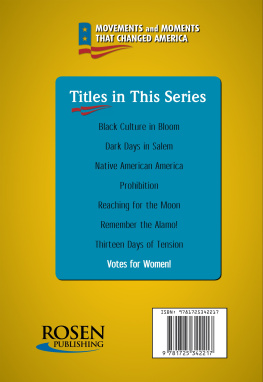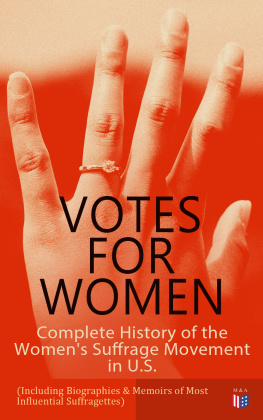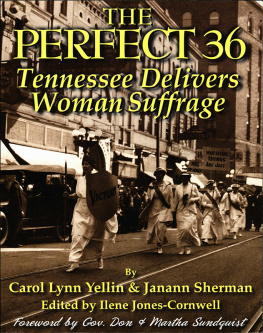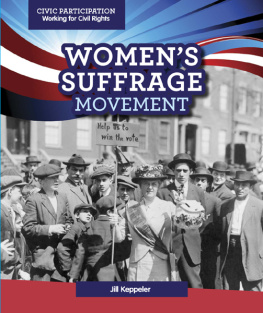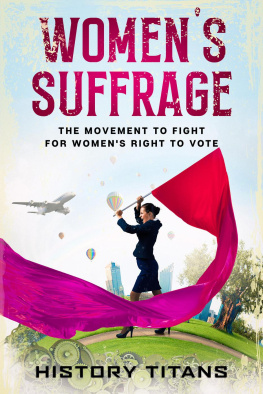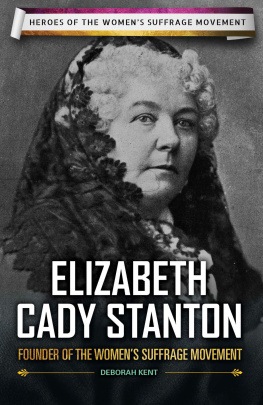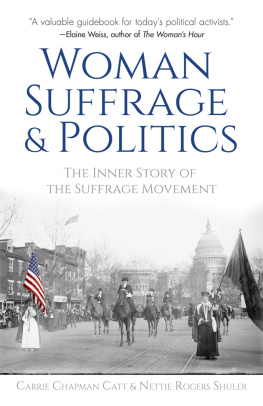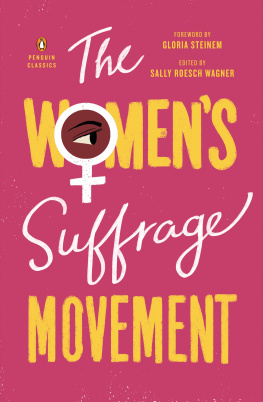

Published by The History Press
Charleston, SC 29403
www.historypress.net
Copyright 2013 by Antonia Petrash
All rights reserved
Cover image: Pin (back) equates patriotism with suffrage. The twelve stars mean that twelve states had passed suffrage at that time, probably 1917, when New York become the twelfth state to grant women full suffrage. Courtesy of Suffrage First Media Project, authors collection.
First published 2013
e-book edition 2013
Manufactured in the United States
ISBN 978.1.61423.964.2
Library of Congress Cataloging-in-Publication Data
Petrash, Antonia.
Long Island and the woman suffrage movement / Antonia Petrash.
pages cm
Summary: A history of the suffrage movement and its important activists on Long Island--Provided by publisher.
print edition ISBN 978-1-60949-768-2 (pbk.)
1. Women--Suffrage--New York (State)--Long Island--History--20th century. 2. Suffragists--New York (State)--Long Island--History--20th century. 3. Suffragists--New York (State)--Long Island--Biography. 4. Long Island (N.Y.)--Politics and government--20th century. 5. Long Island (N.Y.)--Biography. I. Title.
JK1911.N7P48 2013 324.623097472--dc23 2013021766
Notice: The information in this book is true and complete to the best of our knowledge. It is offered without guarantee on the part of the author or The History Press. The author and The History Press disclaim all liability in connection with the use of this book.
All rights reserved. No part of this book may be reproduced or transmitted in any form whatsoever without prior written permission from the publisher except in the case of brief quotations embodied in critical articles and reviews.
CONTENTS
PREFACE
Wait. Wait, they were told.
Work hard. Learn about the political system and how to work within well-established organizations. Nonviolent methods are best, as they do not create hard feelings.
Dont make waves. Dont make enemies. People dont like strident, outspoken women. Have patience. Success will come in due course. Your time will come.
And so they worked and waited. They waited through the long Civil War, supporting African American men and women in their bid for freedom. Surely, once the war was won and the slaves were freed, there would be time for all men and women to be granted equal suffrage.
They endured the long, frustrating years after the Civil War when their dreams were shattered and the freed African American male slaves were granted the vote first. They had worked tirelessly for abolition because they sincerely believed in the cause and because they thought that it would provide the path to equal rights they so desperately wanted.
They wrote books, letters, articles and petitions and published newspapers, leaflets and pamphlets. When they could not afford to publish their own newspapers, they begged for space in others.
They choreographed stunts, rode in wagons, flew in airplanes and teetered on billboards high over the ground. They marched through the wind and the cold, trudged through endless neighborhoods asking for signatures on petitions and made speeches on trains, in drafty auditoriums and on cold and dirty street corners. They were jeered, attacked, jailed, beaten, force-fed and vilified.
And when victory came, it was not because they had waited. It came, in fact, because they finally realized they could wait no longer.
ACKNOWLEDGEMENTS
A book that depends on such intensive research such as this never represents just the work of the author alone; rather, it depends heavily on the assistance of historians, archivists, librarians and like-minded friends who love history and delight in its study and preservation. I am indebted to a host of friends and colleagues without whose assistance and support this book would never have become a reality.
Although I cannot mention them all, special thanks goes to my commissioning editor Whitney Landis, who fielded my panic-stricken e-mails with grace and kindness, and to Dr. Natalie Naylor, the authority on womens history on Long Island, who has been most generous with her continued assistance and support. Thanks also to Arlene Hinkemeyer, who generously shared her files on the suffragists on the East End of Long Island; Suzanne Johnson, director of the Longwood Public Library, who provided me with a wonderful list of suffrage leaders in Suffolk County; and Mark Rothenberg of the Patchogue-Medford Public Library, who shared his files and information on Elizabeth Oakes Smith. I am also grateful to Eleanor Noble and Myrna Sloam and the librarians of the Roslyn-Bryant Library, who helped me research and illustrate the life of Katherine Duer Mackay; Betsy DeMaria of Sagamore Hill National Park Service, for her help with photos of Theodore Roosevelt; Peg Johnston, who generously shared her files, photos and information about Elisabeth Freeman; Assemblyman Charles Lavine and his assistant, Christian Paul, who helped with information about Ida Bunce Sammis; and State Senator John Flanagan, who shared his fathers delightful essay on Ida Bunce Sammis and helped bring her to life.
Kathryn M. Curran and Edward Smith of the Suffolk County Historical Society helped me research and illustrate the life of Rosalie Gardiner Jones; Elspeth Kursh at the Sewall-Belmont House in Washington, D.C., offered assistance with photographs and information; Ronnie Lapinsky-Sax generously shared an image from her wonderful collection of woman suffrage memorabilia; and Elly Shodell of the Port Washington Public Library offered information and contacts about Harriet Burton Laidlaw. Thanks also to Victoria Aspinwall of the Long Island Studies Institute at Hofstra University; Susan Barker of the Sophia Smith Collection at Smith College; Stephanie Gress of the Suffolk County Vanderbilt Museum; and Cheryl Klimaszewski of Bryn Mawr College Special Collections.
I am especially grateful to my wonderful friend Marguerite Kearns, who has generously shared the wonderful stories of her grandmother, Edna, and has offered unstinting encouragement and support. Lastly, I am especially indebted to my own personal circle of inspiration: my friends and colleagues at the Glen Cove Public Library, Director Kathie Flynn and librarian/archivists Carol Stern, Rosa Cella and Jan Angliss; my supportive friends who never tired of asking about the project and commiserating with me about its problems; my sisters, daughters, sons-in-laws and grandsons; and, of course, my wonderful husband, Jack, whose steadfast support and encouragement continues to help me turn my dreams into realities.
INTRODUCTION
We hold these truths to be self-evident; that all men and women are created equal; that they are endowed by their Creator with certain inalienable rights; that among these rights are life, liberty and the pursuit of happiness.
Declaration of Sentiments, Seneca Falls, 1848.
On a warm July day in 1848 in Waterloo, New York, five quite ordinary women gathered around a tea table in Jane Hunts parlor to discuss their dissatisfaction with womens life in general. Jane was joined by Quakers Lucretia Mott and her sister, Martha Wright, as well as by neighbors Mary Ann McClintock and Elizabeth Cady Stanton. While all five were frustrated by the inequities they faced as women, the most discontented of all was Elizabeth Cady Stanton, who vehemently poured out her discontentwith womans portion as wife, mother and housekeeper.


